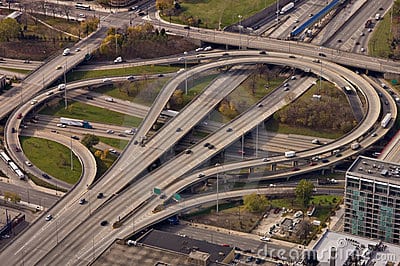There was a not-so hidden message for Australia’s Prime Minister at the Festival of Ideas in Melbourne on Wednesday afternoon. Speaking at the University of Melbourne’s Carillo Gantner Theatre, Professor Rob Adams – an architect and urban designer, and Director of City Design at the City of Melbourne – declared there was not a city in the world that had solved its modern-day infrastructure problems by building another road.
On the contrary, said Adams, gesturing towards an aerial-view image of a clover-leaf highway; once a government had built a major new road like that, it had failed.
So perhaps Tony Abbott, who has promised to use funds siphoned from Australia’s foreign aid account to build the roads of the 21st century, should take note. (The Victorian state government might also take note, as it faces off with local protesters over its $8 billion plans to build a new East West Link road and tunnel in Melbourne.)
“The issue is bigger than building a tollway,” Adams said. “We need to devise a 21st Century solution, rather than 20th Century.” And in his opinion, the best way for governments to bolster existing urban infrastructure is to invest in more public transport – and preferably buses.
Buses, said Adams, speaking as part of the Festival’s Day One session on Environments, were Melbourne’s transport blind spot. Much cheaper than tunnels, bridges and highways; and quicker, lighter – cleaner, if they’re electric – and more easily integrated than any other form of public transport, they should be used for transit interchange, to help make seamless connections.
With more than half of the world’s population living in cities, and roughly a Copenhagen-worth of new urban dwellers added each week, the second session of this year’s Festival of Ideas in Melbourne was dedicated to “The Liveable City,” with three speakers presenting their ideas on how to approach the major challenges of burgeoning urban populations – and do so sustainably.
According to Adams, strategic medium density with better public transport and greener infrastructure is the way to go. But how do we get governments to see this?
“Governments need to think about what the real problem is,” he told the audience on Wednesday. And for cities like Melbourne, he said, one problems seems to be how to reduce congestion on its roads by around 7 per cent (which, he notes, is about how much is falls by every school holiday period).
“The most inefficient way to use a road is to put a car on it,” Adams said. Instead, he urges urban planners to design streets that encourage more pedestrians, bicycles, trams and, of course, buses.
And this “21st century thinking” should extend to urban residential development, he says – which means going up, instead of further developing the urban sprawl.
“Technology can now simulate what the environments of the future are going to look like,” Adams said, urging governments to look past planning schemes and “documents” to address growth and climate change, and look towards the new reality – more affordable, high density housing and greener infrastructure for energy generation, waste management, transport and water use.










